A Brief History of the NAB Show
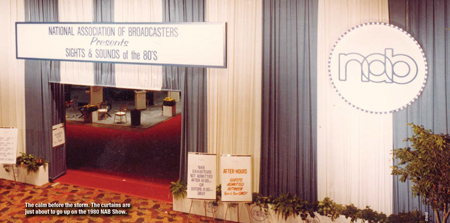
The calm before the storm. The curtains are just about to go up on the 1980 NAB Show.ALEXANDRIA, VA.—Next month, many of us will be heading forLas Vegas and the NAB Show. Hands down, it’s the biggest exhibition and conference in our profession (I also enjoy the IBC and some others, but stats don’t lie), and many of us make it the focus of our year’s activities.
None of us like to admit to getting long in the tooth, but for a number of years now the Ross Video folks have been handing out lapel pins marking the number of NAB Shows the wearer has attended. These top out at 30 years and I received that one quite a few years ago! Actually, my first NAB (we didn’t call it “NAB Show” then), was the last time it was held in Washington, D.C. (For a long time the show flip-flopped between Chicago and D.C.) For those of you who weren’t there—at the last D.C. show that is—the year was 1977 and that event marked the 55th time it had been held. The city didn’t have a convention center back then, so the NAB event was spread over three hotels with shuttle busses connecting attendees with the exhibits and events. The thing was huge; at least from my prospective then. I’d seen my share of TV and radio gear before, but I was the proverbial kid in the candy store. I felt as if I’d died and gone straight to broadcast equipment heaven!
MY FIRST SHOW
So what was the NAB Show like almost 40 years ago?
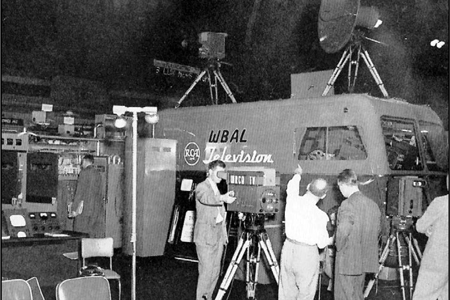
This was part of the scene at the 1947 NAB Show. TV was still in its infancy and an unproven quantity. Exhibitors such as RCA were trying to get some buy-in for the new medium with exhibits such as this one, which included a shiny new remote truck bound for Baltimore’s WBAL-TV. For starters, far and away the largest exhibitors were Ampex and RCA (who?), just as had been the case for a number of years. The really hot thing was a new videotape format—one-inch. Sony (which was beginning to make serious inroads in the broadcast equipment area), was showing off their brand new BVH-1000 machine, and Ampex took the wraps off their VPR-1. Bosch-Fernseh was there also with BCN-50. The video being shown was in every way comparable (or better) to that produced by the industry standard two-inch quadruplex machines being exhibited by Ampex and RCA and there was gossip on the floor that quad’s days were numbered. However, Ampex had announced an editing accessory for their newest quad, the AVR-2 which was quite prominent in their booth and RCA was touting super-high-band operation for their TR-600A quad.
ENG was just getting a toe-hold, with a number of “compact portable color cameras” from the likes of Ikegami, Sony, JVC, Thomson-CSF and RCA. This was cutting-edge stuff, especially when compared to the big studio color cameras we’d been dealing with; however, by today’s standards, they would be called clunky and big. (Prices weren’t exactly cheap, with most selling for between $30K and $50K—between $117K and $195K in today’s money.)
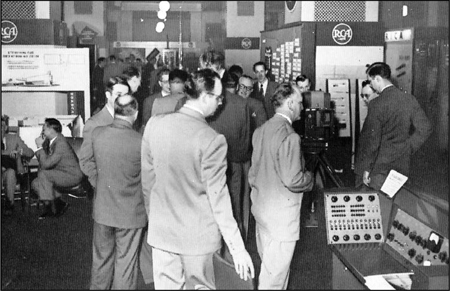
Over the years, there have been a lot of changes in both broadcasting and the NAB Show; however, a big attraction is getting to see new gear, just as in this 1951 photo. (Show “dress codes” have changed a bit though.) Even though ENG was getting a lot of attention, Kodak was at the show touting their latest 16mm color film for newsgathering. It had an exposure index of 400 ASA and could be pushed to 1,600 in processing if needed to provide usable pictures with as little as five foot-candles of light.
Get the TV Tech Newsletter
The professional video industry's #1 source for news, trends and product and tech information. Sign up below.
Another big attention getter and high-tech item was the electronic stillstore. I recall seeing several, but Ampex dominated with its ESS which filled up a couple of racks plus another two office safe-size standalone hard drive units. The age of the digital TBC had arrived and at least a couple of companies were showing off this technology. (However, they came with rather steep price tags—around $60K in today’s money.
The 1977 show was also where I got my first look at PAL and SECAM video, courtesy of Ampex, which showed 625-line versions of their VTRs playing 625-line tapes recorded in the two formats.
MEMORABLE IN OTHER WAYS TOO
The 1977 show was not all sweetness and light, though. The nearly 13,000 attendees completely swamped Washington hostelry, with a good number of people unable to get rooms anywhere in the area at any cost. As I recall, there was such an uproar over this that several attendees pulled out of NAB as a symbolic gesture. Although the NAB had already scheduled the 1978 show for Las Vegas, the organization went on record saying that it would never schedule a show in D.C. again until a convention center was built. (I was a local, living in northern Virginia, so this was a “commuting” NAB for me.) However, the sitting U.S. President, Jimmy Carter, who was living just a few blocks from the activities, took some heat for not at least putting in a cameo appearance at the show. (Vice President Walter Mondale did stop by, as did outgoing FCC Chair Richard Wiley; however, I didn’t get to see either of these gentlemen.)
In case you’re wondering—no, the NAB Show never returned to Washington, even though two convention centers were built in the intervening years.
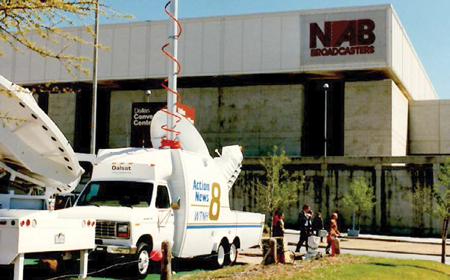
In the 1980s, satellite downlinks and ENG vehicles were becoming an integral part of all TV broadcast operations. This was the outdoor scene at one of the Dallas NAB Shows, with the van shown putting in an appearance before the keys were handed to its new owner, New Haven’s WTNH (a former employer of the author). After Vegas, it went on to play Dallas in 1979 and was held there for a number of years. I did all of the Dallas NABs and remember them as great shows held at a convention center that could accommodate everything under one roof. Unfortunately (like the last D.C. show), the number of hotel rooms near the Dallas Convention Center were woefully inadequate to accommodate the number of attendees, so it took 30 minutes or longer on shuttle buses for most of us to reach accommodations in outlying hotels and motels. (Then VTR king Ampex did score some points with attendees at one of the Dallas shows with bus rides though. The television series “Dallas” was in full swing then and the company organized an evening party at a real working ranch somewhere on the outskirts of the city, and bused scores, if not more, of invitees there to enjoy real Texas hospitality capped off with barbecue served from a chuck wagon. This was a real treat, especially for attendees who had never traveled to the U.S. before.)
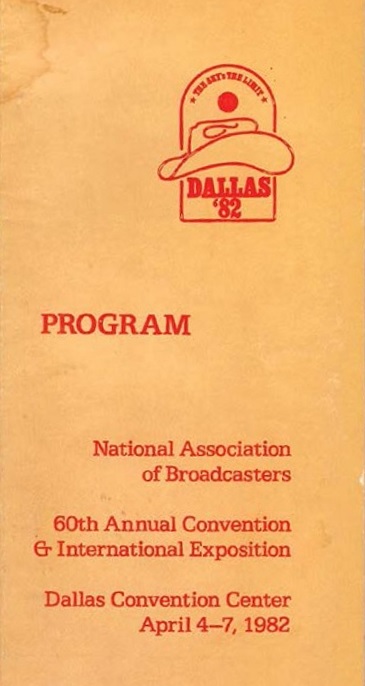
Show programs were a lot smaller a few years ago, as evidenced by this example from 1982. It consisted of 140 pages (plus show floor maps) and could be easily carried in one’s pocket.NAB SHOWS THROUGH THE AGES
Just for the record in this ramble about NAB Shows of the past: The first-ever show (1923) was not in Washington, but rather in New York; it arrived in the nation’s capital five years later. It played Chicago for the first time in 1936 and again the next year, but didn’t return again until 1943. Actually, the show moved around a lot during its early years. Venues played in the 1920s, ’30’s and ’40’s included Atlantic City, Cleveland, Cincinnati, San Francisco, St. Louis, White Sulfur Springs, W. Va., and even once in West Barden, Ind. (don’t ask me why).
The show alternated between Washington and Chicago starting in the early 1950s, with Los Angeles thrown in a couple of times during this era. It played Houston in 1974 and tried out Las Vegas for the first time the following year.
A MUST-DO!
As I mentioned at the beginning, the NAB Show is at the top of the list for broadcast-related events during the calendar year. It’s an opportunity to check out all the latest equipment and technologies; a chance to sit in on some really informative engineering and other seminars; and for many of us who have been attending the show for a number of years, it’s also an opportunity to meet with many, many old friends, some of whom have retired but still can’t get the coax and flashing lights out of our systems.
I hope to see you at the 2016 Show!
